Trauma Is Stored in the Body: Understanding the Mind-Body Connection in Healing
Discover how trauma is stored in the body, how it affects the nervous system, and gentle ways to heal through trauma-informed, body-based therapy.
When we talk about trauma, most people think about emotional pain or distressing memories. But trauma isn’t just something that lives in the mind — it’s something that lives in the body.
Our bodies remember what our minds can’t always put into words. The tightness in your chest, the knot in your stomach, the exhaustion that won’t ease — these are not random symptoms. They’re your body’s way of saying, “I’m still holding on.”
In this post, we’ll explore what it means when we say trauma is stored in the body, how the nervous system responds to trauma, and gentle ways to begin reconnecting with your body in the healing process.
What Does It Mean That Trauma Is Stored in the Body?
When we experience something overwhelming — an accident, abuse, loss, or ongoing stress — our body immediately activates its built-in alarm system: the fight, flight, freeze, or fawn response.
This survival system is designed to protect us. Adrenaline and cortisol surge through the body to help us run, fight, or endure danger.
However, if the threat is too much, too sudden, or too prolonged — and we don’t have the safety or support to process what happened — that survival energy doesn’t just disappear when the event ends. It can stay stuck in the body.
We might experience:
Chronic tension or pain
Digestive issues
Fatigue or insomnia
Feeling “on edge” or disconnected from emotions
Sudden overwhelm or panic when triggered
These are all signs that the nervous system is still trying to protect us from a danger that’s no longer present.
The Science Behind Trauma and the Body
Psychiatrist and researcher Dr. Bessel van der Kolk popularised the phrase “the body keeps the score.” His research shows that traumatic experiences alter the way our brains and bodies process information.
Key brain areas involved in trauma include:
Amygdala: the brain’s alarm system, often hyperactive after trauma
Hippocampus: helps process memories but can become impaired, making it harder to differentiate between past and present threats
Prefrontal cortex: the rational part of the brain that can go “offline” during trauma
This means the body can continue responding as if the danger is still happening — even years later.
How Trauma Manifests in the Body
Everyone experiences and stores trauma differently. For some, it shows up physically; for others, emotionally. Common body-based signs include:
Jaw clenching or teeth grinding
Tight shoulders, chest, or neck
Feeling frozen, numb, or disconnected from the body
Difficulty breathing deeply
Sudden bursts of anger, fear, or tears
Trouble relaxing or sitting still
These are not signs of weakness — they’re protective responses that once helped you survive.
Why Talking Alone Isn’t Always Enough
Traditional talk therapy focuses on cognitive processing — putting thoughts and feelings into words. While this can be incredibly healing, it often doesn’t address the body’s memory of trauma.
That’s why many trauma-informed approaches combine talk therapy with somatic (body-based) techniques. These help release stored energy and re-teach the body that it’s safe to relax and feel again.
Examples include:
Somatic Experiencing (SE)
Eye Movement Desensitisation and Reprocessing (EMDR)
Trauma-Sensitive Yoga or Breathwork
Grounding and mindfulness practices
These methods help regulate the nervous system and bring awareness back to the body in gentle, safe ways.
Reconnecting With Your Body: Gentle First Steps
If you’re just beginning this journey, know that you don’t need to rush. The goal isn’t to “fix” or force your body to relax — it’s to build a sense of safety and trust within it again.
Here are a few small ways to begin reconnecting:
Notice your body’s signals — Where do you feel tension? What happens when you take a slow breath?
Ground yourself in the present — Feel your feet on the floor, name what you can see, hear, and touch.
Move gently — Try stretching, walking, or yoga designed for trauma recovery.
Practice mindful breathing — Inhale slowly, exhale longer, and remind your body it’s safe now.
Work with a trauma-informed therapist — Healing is safest and most effective when supported.
Healing the Body, Healing the Mind
Healing from trauma takes time, patience, and compassion. The good news is that the body can learn to feel safe again.
When we include the body in the healing process — rather than fighting against it — we create space for deep and lasting change.
You are not broken. The reactions, sensations, and patterns you experience are signs of how hard your body has been working to protect you.
With the right support, that same body can become your greatest ally in healing.
If You’re Ready to Begin Healing
If you’re curious about exploring body-based trauma healing or want support from a trauma-informed therapist, I offer compassionate, evidence-based therapy to help you reconnect with safety and self-trust.
You don’t have to navigate this alone. Healing is possible — gently, at your pace.
[trauma stored in the body, trauma and the nervous system, body keeps the score, somatic therapy, trauma-informed counselling, healing trauma, trauma and body connection, nervous system regulation, trauma recovery, mind-body healing]
Darwin, NT - with virtual services nationally
info@adaptablesupport.com
© 2025. All rights reserved.
